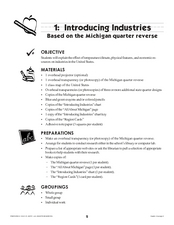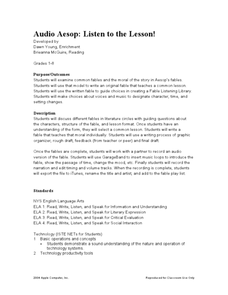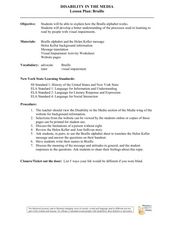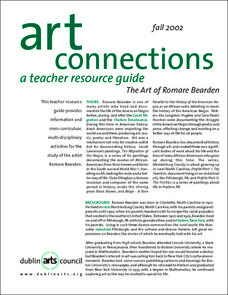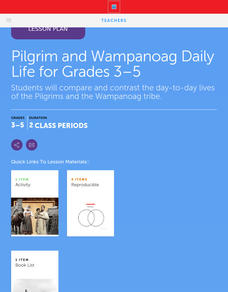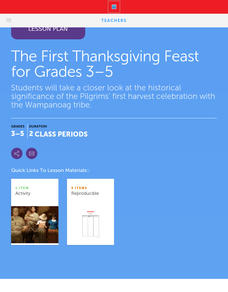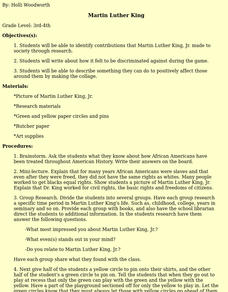Curated OER
Introducing Industries
If you are looking for a way to explore Michigan's resources, physical features, and more, this lesson is for you. After discussing Michigan and the Great Lakes, learners fill out a graphic organizer identifying the state's natural...
Curated OER
Survival of Native American Culture
Students research the five tribes of the Iroquois Nation focusing on housing, food, clothing, transportation, religion, and language. They research using Internet sources and book mark sites for reuse.
Curated OER
Places We Live
With a wonderful bibliography to support this instructional activity on Illinois, President Lincoln, and rural vs. urban settings, this activity is a motivating experience. The instructional activity begins with pupils exploring books,...
K12 Reader
I Have a Dream… Personal Narrative: Writing About Your Dream for the World.
How do your pupils want to change the world? Find out with this writing prompt, inspired by Dr. Martin Luther King, Jr.'s well-known speech. The resource provides the prompt and lines for writing.
Council for Economic Education
Teaching Economics Using Children's Literature
Introduce young learners to the subject of economics using their favorite stories and books. Including 24 separate lessons, this guide covers economic principles such as trade, scarcity, consumer goods and services, renewable and...
Curated OER
Audio Aesop: Listen to the Lesson!
Aesop's Fables are the focus of this language arts lesson. Young philosophers study and discuss the morals found in the most famous of Aesop's Fables. They write an original fable that teaches a common moral. A "Fable Listening Library"...
Curated OER
Disability in the Media Lesson Plan: Braille
Students determine the workings of the Braille alphabet and how people with visual impairments learn how to use it. In this Braille lesson, students study the associated vocabulary, read about Helen Keller, and complete associated...
Classics for Kids
Listen to the Music
Different pieces of music can elicit different emotions from audience members. A quick tempo can make you feel happy, while a largo piece may bring out a melancholy temperament. Elementary musicians learn more about the instruments...
Curated OER
Creating An Understanding of the Past/Through The Art of George Catlin and Native American Artifacts
Students explore Native American culture. They observe and discuss the paintings of George Catlin. Students examine the lives of the Pawnee Native American Indians during the time period of 1830-1840. Numerous cross curriculum activities...
Curated OER
Kids' Bread Restaurant
Learners use technology as a tool for learning. They work together on a special project.
Curated OER
Visual Art: Romare Bearden and Group 306
Students examine the life and art of Romare Bearden. Using his "Mill Hand's Lunch Bucket" for inspiration, they write a first chapter for a book. Students observe numerous other works of his art and discuss them from artistic and...
Curated OER
1,000 Cranes
Young scholars improve motor skills through careful folding, a discipline necessary in the practice of origami. They develop multicultural awareness by exploring Japanese history.
Curated OER
Wrap It Up for Chanukah!
Prepare gifts for the eight nights of Hanukkah with a fun and artistic instructional activity. Learners use various materials to make an array of unique gifts, including splatter paintings, decorated flowerpots, and stained glass...
Curated OER
Working Animals
Learners discuss the role of animals and how they can work with people to better the community. In this working animals lesson plan, students discuss how animals and people work together to complete different tasks in the community.
Museum of Tolerance
Immigration Journeys
Through the journey of four stories of immigration, scholars complete graphic organizers and apply knowledge to create a visual representation of their findings on a large poster. Third and fourth readers write a letter to their...
Curated OER
Symbols and Trading Cards
A silk rank badge was a symbolic emblem worn by high officials during the Qing Dynasty. Your class will get a chance to examine the details, symbolism, color, and design of such a badge as they make their own symbolic trading cards....
Museum of Tolerance
Quilt Activity
After completing the first five lessons from the series, scholars assemble their quilt pieces to create a family history quilt. They then rate their experience of learning about their families by conducting interviews, creating family...
Scholastic
Voyage on the Mayflower for Grades 3-5
Following an online activity, scholars complete a Grafitti Wall in which small groups write words and phrases on chart paper pertaining to Pilgrims, the Mayflower, and Thanksgiving. Pupils perform a close reading then answer a series of...
Scholastic
Pilgrim and Wampanoag Daily Life for Grades 3-5
Thirteen steps make up a lesson plan that challenges pupils to compare and contrast the daily lives of Pilgrims and the Wampanoag tribe. Learners revisit the Graffiti Wall then break into small groups for an investigative reading...
Scholastic
The First Thanksgiving Feast for Grades 3-5
Scholars examine the first Thanksgiving through books and interviews while they complete a KWL chart. Pretending they are part of the feast, learners craft a scrapbook page that features images related to their experience. Pupils reflect...
Curated OER
Music: Off the Wall & Onto the Stage - Composing
Kids explore Gullah music from Africa and then create original compositions based on what they've learned. They practice traditional melodies and rhythms then make some of their own, which they then perform for the class.
Channel Islands Film
Dark Water: Lesson Plan 2 - Grade 3
A discussion of bioluminescence launches an investigation of animal adaptations. After re-watching the opening minutes of Dark Water, class members listen to a reading of What Do You Do with a Tail Like This, and then create a new...
Curated OER
Martin Luther King
Identify contributions that Martin Luther King, Jr. made to society through assigning a research project! Third and fourth graders write about how it felt to be discriminated against during the game. They describe something they can do...
